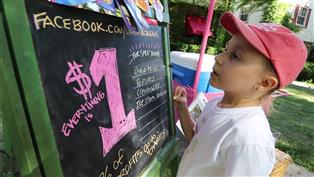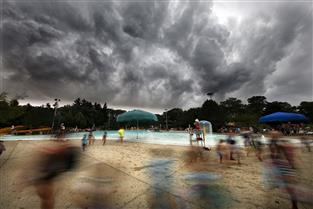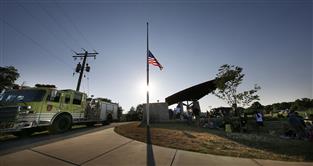The Safe Routes to School program is pursuing expansion, hoping to engage parents at schools beyond McKinley Elementary, where the initiative began.
At the same time, Sarah Lerand, a McKinley parent and a founder of the program, has released a districtwide survey of elementary school parents that reveals the fears and motivations that influence decisions about how kids get to and from school.
"If we're going to change behavior, it helps to change the whole city, not just little pockets," Lerand said at a meeting of representatives of a handful of schools, including Madison, Roosevelt, Eisenhower, Underwood, Washington, Montesorri, Roosevelt and Longfellow.
The subjects of discussion at the meeting, held last week, ranged widely while staying focused on how kids get to school, promoting safety and the health benefits of walking and biking.
Ideas abound
Molly Del Vecchio, an Eisenhower parent, said she was promoting a park-and-walk concept. She parks a distance from the confusion of the Center Street pickup zone, which is compounded by three schools lined up in a row. Walking with her child, they both get exercise, and "it's so great to be one less car on Center Street."
Creating "bike trains," like walking school buses on bikes, was another suggestion. Sarah Hunt Frank, a Roosevelt parent, and others discussed the idea of local bike rodeos - which would offer safety tips, bike checks and helmet fittings - as a way of promoting biking.
"Every school should have a bike rodeo," said Deb Sellers, who lives in the Underwood area.
Lerand discussed her outreach to the crossing guard provider, Twin City Security, and the crossing guard ambassador program, through which a parent would get to know the guard, ask if there were concerns about student behavior and serve as conduit for other parents who had concerns about the guard or about students' crossing behavior.
The group spent some time discussing guard placement, and how many students an individual guard serves at various locations. Members discussed a plan to count the number of kids served by area crosswalks, to see if there might be better placements.
Some data on this is provided in Ayres Associate's school dropoff study of Madison Elementary, noted Madison parent Jason Kauflin. This is also the case of data on the Center Street schools.
Tristan Almazan, a Madison school parent who said she moved here two years ago, wondered at the lack of busing, and why the district itself is not leading the way on safe and healthy student transportation.
"Why does it have to be grassroots?" she asked.
Lerand said a Safe Routes program is stronger and more successful if it is a part of the school's PTA.
The parent survey
Almost 3,000 questionnaires were distributed to elementary school parents, and about 500 were returned. Those who responded made up for the low rate of return in the parent comments section of the survey. More than 200 people wrote sometimes extensive and passionate comments about how they get their students to school, and why they have chosen what they have chosen.
More comments were recorded from Eisenhower parents, at 37, than for any other school, reflecting, perhaps, the complex dropoff situation there. The lack of regular bus service came up in a number of comments; the absence of sidewalks, and heavy and unpredictable traffic also were noted by many.
"We have walked home in the warmer weather, but I would never let my children walk to school, as we live one mile away, there are no sidewalks and there is far too much traffic in the morning," wrote one parent.
Some expressed a desire for a more organized walking program, like a walking school bus, led by parents or older siblings.
"Could there be some sort of organization for elementary students to meet up with older siblings?" asked a respondent.
The Eisenhower parking lot was variously described as a "disaster," a "mess," and "dangerous," and the drivers on Center Street as "obnoxious" and "too fast."
Parents at Madison complained about illegally parked cars that force pedestrians to walk in the street, because there are no sidewalks.
A number of parents who responded throughout the district were concerned about "stranger danger."
"It is mostly my fear of her being taken," one parent said of why her child isn't allowed to walk to school.
Here and there throughout the responses, it was indicated that children want walk, but aren't allowed to.
Where schools are less than a quarter-mile away, 67 percent of respondents said their child had asked permission to walk. Even for those living a half-mile to a mile from school, 59 percent of parents responding said their child had asked to walk to school.
But, as Lerand pointed out, actually walking to school falls dramatically when the distance exceeds a quarter-mile.
Lerand and Alderman Jeff Roznowski plan to discuss the survey with Superintendent Phil Ertl in a mid-April meeting.
"People are obviously thinking about this issue, have feelings about the issue, and were able to express it," Lerand said.
More from News and Features
- Anodyne Coffee plans to open location in Wauwatosa Village
- Wauwatosa Meetings: Aug. 4
- Video: Wauwatosa girl's curbside ice cream stand raises money for the hungry
- Wauwatosa News and Notes: Hands-only CPR training offered; Firefly Art Fair is Aug. 6-7
- Wauwatosa Ask Now: Why are there barriers and fencing along the North Avenue bridges over the Menomonee River?
- Mystery Photo Contest: July 28
- Wauwatosa gears up for National Night Out event, this year at the zoo
- Election 2016: Wisconsin's 4th District candidates weigh in
- Wauwatosa's Luther Manor residents share smiles through flower delivery
- Wauwatosa Police Report: July 17-23














